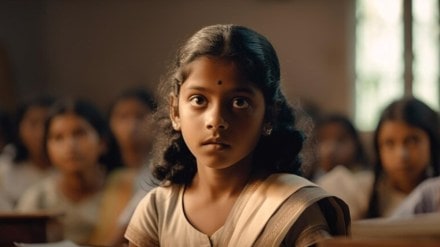Education is a fundamental right, yet for many girls in India, it remains an elusive goal. A recent study named ‘Educating the Girl Child,’ sheds light on the critical barriers to accessing and continuing education for girls and evaluates the effectiveness of various incentivisation schemes. This comprehensive analysis provides a nuanced understanding of the factors influencing educational outcomes for girls and highlights potential areas for improvement.
The study surveyed 1,604 girls, revealing that 16% of them were not currently attending school. Notably, Gujarat accounted for half of these dropouts, indicating significant regional disparities in educational continuity. This finding underscores the need for targeted interventions in states with higher dropout rates.
Socio-economic influences
A significant majority of the dropout girls came from socio-economically disadvantaged backgrounds. More than half of the parents interviewed were mothers, predominantly from the Hindu community (93%) and other backward classes (40.3%). Approximately 35% of these households had a monthly income below Rs 5,000, highlighting the direct correlation between poverty and educational challenges.
Family income and educational spending
Family income emerged as a critical determinant of educational expenditure. Lower income levels are associated with reduced spending on education, which can adversely affect girls’ school attendance and continuation.
The study found that most dropout girls were aged between 15 and 18 years (76%). Haryana reported the highest dropout rate (88%), followed by Andhra Pradesh (76%). In contrast, Bihar had a higher percentage of dropouts in the 11-14 age group (37%). This variation suggests that interventions must be tailored to address age-specific needs across different states.
Social and economic disparities
Dropout girls predominantly belonged to socially and economically deprived categories. Only 18% had mothers who could read and write and around 35% came from scheduled tribes. In Bihar, 56% of dropouts were from scheduled castes, while Gujarat saw a larger proportion from scheduled tribes. These statistics highlight the intersection of social status and educational access.
Reasons for dropout
The study identified school distance and unaffordability as major reasons for girls dropping out. Additionally, many girls were found to be engaged in unpaid household chores or assisting with family labor, further impacting their ability to continue education.
“Gender discrimination and violence are key factors contributing to the dropout rates among one in five girls. While campaigns to shift community attitudes towards girls are crucial, fostering a change in teachers’ attitudes is also essential for preventing violence against girls,” Paresh Kumar, Co-Founder and CEO, DevInsights Pvt. Ltd., which was the research partner of the study, said.
As per the study, the absence of female teachers was another significant factor contributing to absenteeism. About 18% of girls expressed discomfort in the absence of female teachers, pointing to the need for gender-sensitive staffing in schools.
Factors leading to absenteeism
Household chores and illnesses were the primary reasons for girls’ absenteeism. Menstruation also emerged as a key factor in states like Haryana, Andhra Pradesh and Gujarat. Despite the Swachh Vidyalaya Mission, only 87% of schools had separate toilets for girls, with Bihar performing better than other states in this regard.
Incentives and benefits
Incentives such as scholarships (54%) and free books (35%) were commonly reported among school-going girls. However, 31% of the girls did not receive any benefits. Haryana had a higher proportion of girls (58%) not receiving school benefits, whereas Gujarat had the lowest percentage (1.5%).
“Surprisingly, at the time of the study, only 60% of parents with school-aged girls were aware of any schemes promoting girl child education. Among those familiar with these initiatives, the Mukhyamantri Cycle Yojana (specific to Bihar) and Beti Bachao Beti Padhao (a national scheme) were the most recognised,” Kumar added.
The study also uncovered gender-based disparities in parental perceptions. Parents generally preferred their sons to pursue longer education and believed that girls performed more household work than boys. This highlights the need to address deep-rooted gender biases that affect educational priorities.
